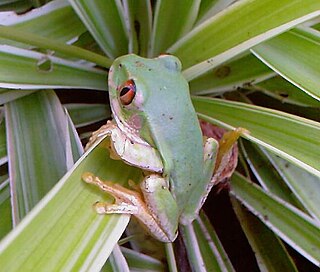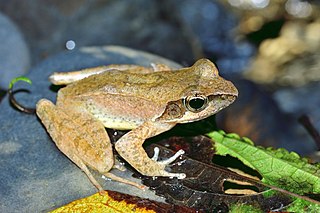
The Tyrrhenian painted frog is a species of frog in the family Alytidae. It is found in Sardinia, Corsica, and the Tuscan Archipelago.

The Sardinian tree frog or Tyrrhenian tree frog is a species of frog in the family Hylidae, found in Corsica, Sardinia, and the Tuscan Archipelago.

The Shensi tree frog is a species of frog in the family Hylidae endemic to China. Its natural habitats are temperate shrubland, rivers, intermittent rivers, swamps, freshwater marshes, intermittent freshwater marshes, and irrigated land. It is threatened by habitat loss.

Wright's mountain tree frog is a species of frog in the family Hylidae found in Mexico and the United States. Its natural habitats are temperate forests, temperate grassland, rivers, and freshwater marshes. Dryophytes wrightorum has been regarded as a synonym of Dryophytes eximius, the mountain tree frog, which is listed as the state amphibian of Arizona. As presently circumscribed, Drophytes eximius is endemic to Mexico and does not occur in Arizona. It is the state amphibian of Arizona.

The Natal forest tree frog is a species of frog in the family Arthroleptidae, subfamily Leptopelinae, and is endemic to the eastern coastal area of South Africa. A typical tree frog, it has large eyes and a broad mouth. Its colouration is highly variable: Some may be bright green, others cream coloured, and some may be cream with olive-green blotches.
The long-toed tree frog is a species of frog in the family Arthroleptidae found in South Africa and possibly Lesotho. Its natural habitats are temperate grassland, swamps, freshwater marshes, and intermittent freshwater marshes.
Pleurodema bufoninum, the large four-eyed frog or sapo de cuatro ojos grandes, is a species of frog in the family Leptodactylidae. It is found in Argentina and Chile. Its natural habitats are subantarctic forests, temperate forests, subantarctic shrubland, temperate shrubland, subtropical or tropical dry shrubland, subantarctic grassland, temperate grassland, intermittent rivers, swamps, intermittent freshwater marshes, arable land, rural gardens, ponds, and open excavations. The common name "four-eyed frog" refers to two inguinal poison glands that resemble eyes. When threatened, the frog lowers its head and raises its rear. When the frog adopts this posture, the poison glands are also raised toward the predator. The predator may also confuse the frog's raised posterior for the head of a larger animal.
Megophrys huangshanensis is a species of frog in the family Megophryidae. It is endemic to the Huangshan mountains in southern Anhui province, China. Its natural habitats are temperate forests and rivers. It is threatened by habitat loss.
The whistling rain frog is a species of frogs in the family Brevicipitidae. It is found in South Africa, Eswatini, and possibly Mozambique. Its natural habitats are temperate forests, dry savanna, moist savanna, and sandy shores. It is threatened by habitat loss.

The forest rain frog is a species of frog in the family Brevicipitidae. It is endemic to Limpopo, South Africa. Two allopatric subspecies are recognized: the nominate one, Breviceps sylvestris sylvestris, and Breviceps sylvestris taeniatusPoynton, 1963 from near Soutpansberg. Its natural habitats are temperate forests, temperate grassland, and rural gardens. It is threatened by habitat loss.

The plaintive rain frog or rough rain frog is a species of frog in the family Brevicipitidae. It is found in Lesotho, South Africa, and Eswatini. Its natural habitats are temperate forests, dry savanna, temperate shrubland, temperate grassland, and rural gardens. It is threatened by habitat loss.
The mixtured pygmy frog is a species of frog in the family Microhylidae. It is endemic to China. Its natural habitats are temperate grassland, subtropical or tropical dry lowland grassland, rivers, intermittent freshwater marshes, and irrigated land. It is not considered threatened by the IUCN.
Amolops granulosus is a species of frog in the family Ranidae that is endemic to China.
Nanorana quadranus is a species of frog in the family Dicroglossidae. It is endemic to central China. Its natural habitats are temperate forest and shrubland, with breeding taking place in small rivers. It is a common species believed to be declining. It is threatened by collection for food and also habitat loss.
The chevron-spotted brown frog is a species of frog in the family Ranidae, endemic to Mount Emei, Sichuan, China. Its natural habitats are temperate forests, freshwater marshes, and intermittent freshwater marshes. It is threatened by habitat loss.

Rana sauteri is a species of true frog endemic to Taiwan. It inhabits low-altitude hill forests and the associated streams. It is an endangered species threatened by habitat loss due to agriculture and infrastructure development. Common names recorded for Rana sauteri include Kanshirei Village frog, Taiwan groove-toed frog, Sauter's brown frog, and Taiwan pseudotorrent frog.

The Perez's frog, also known as Iberian waterfrog, Iberian green frog, or Coruna frog is a species of frog in the family Ranidae. It is native to southern France, Portugal, Spain, and has been introduced to the Canary and Balearic Islands, Madeira, the United Kingdom, and the Azores. In the Iberian Peninsula it is widespread and common.
Rana sangzhiensis is a species of frog in the family Ranidae, the "true frogs". It is endemic to China. It is known only from Mount Tianping, in Sangzhi County, Hunan, and depending on the source, from Mount Dadong in Lianxian County, Guangdong, or from Mount Emei in Sichuan. Common names Sangzhi frog and Sangzhi groove-toed frog has been proposed for it. It was formerly classified in the genus Pseudorana.
Rana zhengi is a species of frog in the family Ranidae that is endemic to Sichuan, China.
Zhangixalus chenfui, also known as Chinese whipping frog or Chenfu's treefrog, is a species of frog in the family Rhacophoridae endemic to China where it is found in Sichuan, Guizhou, Hubei, and Fujian provinces. Its natural habitats are temperate forests, subtropical moist lowland forests, subtropical moist montane forests, subtropical moist shrubland, freshwater marshes, rural gardens, ponds, and irrigated land. It is not considered a threatened species by the IUCN.









